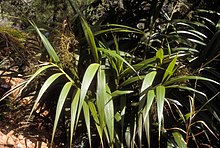
Ceratophyllum is a cosmopolitan genus of flowering plants including four accepted living species in 2016, commonly found in ponds, marshes, and quiet streams in tropical and in temperate regions. It is the only extant genus in the family Ceratophyllaceae, itself the only extant family in the order Ceratophyllales. They are usually called coontails or hornworts, although hornwort is also used for unrelated plants of the division Anthocerotophyta.

Ceratophyllaceae is a cosmopolitan family of flowering plants including one living genus commonly found in ponds, marshes, and quiet streams in tropical and in temperate regions. It is the only extant family in the order Ceratophyllales. Species are commonly called coontails or hornworts, although hornwort is also used for unrelated plants of the division Anthocerotophyta.

Gunneraceae is a family of flowering plants, closely related to Myrothamnaceae, together forming the order Gunnerales. Such a family has been recognized by most taxonomists. Gunneraceae consists of the single genus Gunnera with 63 known species.
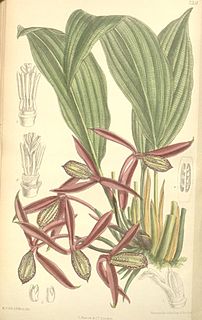
Orchidantha is a genus of flowering plants. In the APG III system, it is placed in the family Lowiaceae, as the sole genus. It includes the plants in the formerly recognised genera Lowia and Protamomum.

The Xyridaceae are a family of flowering plants. This family has been recognized by many taxonomists and is known as the yellow-eyed grass family.

The Oxalidaceae, or wood sorrel family, are a small family of five genera of herbaceous plants, shrubs and small trees, with the great majority of the 570 species in the genus Oxalis. Members of this family typically have divided leaves, the leaflets showing "sleep movements", spreading open in light and closing in darkness.
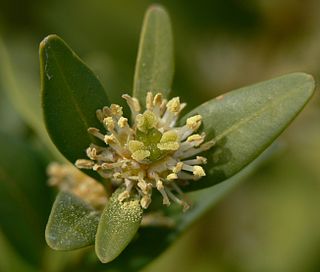
The Buxaceae are a small family of six genera and about 123 known species of flowering plants. They are shrubs and small trees, with a cosmopolitan distribution. A seventh genus, sometimes accepted in the past (Notobuxus), has been shown by genetic studies to be included within Buxus.
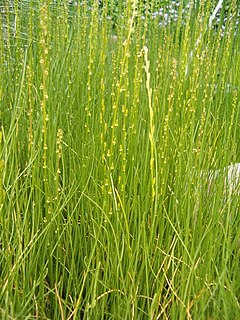
Juncaginaceae is a family of flowering plants, recognized by most taxonomists for the past few decades. It is also known as the arrowgrass family. It includes 3 genera with a total of 34 known species.

Hypoxidaceae is a family of flowering plants, placed in the order Asparagales of the monocots.

Chloranthaceae is a family of flowering plants (angiosperms), the only family in the order Chloranthales. It is not closely related to any other family of flowering plants, and is among the early-diverging lineages in the angiosperms. They are woody or weakly woody plants occurring in Southeast Asia, the Pacific, Madagascar, Central and South America, and the West Indies. The family consists of four extant genera, totalling about 77 known species according to Christenhusz and Byng in 2016. Some species are used in traditional medicine. The type genus is Chloranthus. The fossil record of the family, mostly represented by pollen such as Clavatipollenites, extends back to the dawn of the history of flowering plants in the Early Cretaceous, and have been found on all continents.

Trimeniaceae is a family of flowering plants recognized by most taxonomists, at least for the past several decades. It is a small family of one genus, Trimenia, with eight known species of woody plants, bearing essential oils. The family is subtropical to tropical and found in Southeast Asia, eastern Australia and on several Pacific Islands.
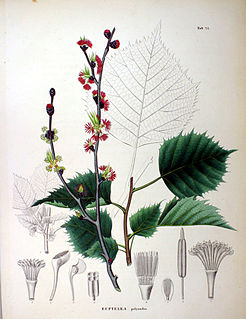
Euptelea is a genus of two species of flowering plants in the monogeneric family Eupteleaceae. The genus is found from Assam east through China to Japan, and consists of shrubs or small trees:

Myrothamnus is a genus of flowering plants, consisting of two species of small xerophytic shrubs, in the southern parts of tropical Africa and in Madagascar. Myrothamnus is recognized as the only genus in the family Myrothamnaceae.

Staphyleaceae is a small family of flowering plants in the order Crossosomatales, native to Europe, temperate and tropical Asia and the Americas. The largest genus Staphylea, which gives the family its name, contains the "bladdernut" trees. The family includes three genera with more than 40 known species.

Ixiolirion is a genus of flowering plants native to central and southwest Asia, first described as a genus in 1821. Recent classifications place the group in the monogeneric family Ixioliriaceae in the order Asparagales of the monocots. In earlier systems of classification, it was usually placed in the family Amaryllidaceae.

Tecophilaeaceae is a family of flowering plants, placed in the order Asparagales of the monocots. It consists of nine genera with a total of 27 species.
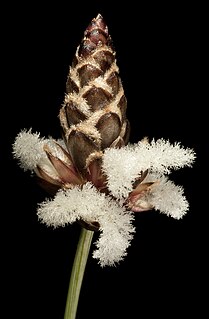
The Ecdeiocoleaceae comprise a family of flowering plants with two genera and three species. The botanical name has rarely been recognized by taxonomists.

Opiliaceae is a family of flowering plants comprising 11 genera and 33 known species. It consists of tropical woody plants. Several genera contain parasitic species. The biggest genus, in number of species and in stature of the individual plants, is Agonandra, the only American genus.
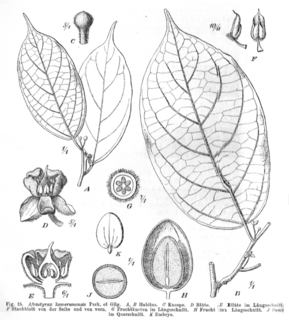
Huaceae is a family of plant in the rosids group, which has been classed in the orders Malpighiales, Malvales, and Violales or in its own order Huales. The APG II system placed it in the clade eurosids I, whereas the APG III system of 2009 and APG IV (2016) place it within the Oxalidales. The family is endemic to central Africa. It contains four species in the following two genera:

Joinvillea is a flowering plants genus in the family Joinvilleaceae. The family consists of one genus with species distributed from the Malay Peninsula to the Caroline Islands and high islands in the Pacific Ocean. It is evolutionarily significant as a relictual group that is a close relative of grasses. They closely resemble large grass plants, in both general appearance and microanatomy, but possess fleshy fruits.
